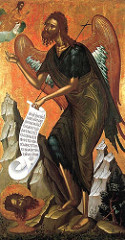
Let’s keep it simple and consider the Gospel of Mark only. No heavy analysis this post; only a moment to look out the window and think over how the arguments of recent posts would affect our reading of Mark.
Firstly, we open with the prophetic announcement. What we are about to read is a fulfilment of prophecy as framed and announced in the opening of the book. The anonymous implied narrator is addressing an implied audience that reminds the real reader of the apparent audience of the prophets of Isaiah and Malachi. (Woops, that does not sound the least bit light. I will avoid repeating the “implied readers/narrators” and “real readers/authors” for the rest of this post, though I am certainly framing everything within those four points of view, and considering how it is all working out between them all.)
That is the way stories in novels and tragedies and epics are guided. Prophecies from the divinity announce what is to happen, and the audience then is held in suspense till they see how it all happens just as predicted.
These same genres use the same device to offer course corrections or details along the way in the middle of the plot. And that’s exactly what happens in Mark, too. Half way through the narrative it is Jesus himself, after demonstrating his “SonOfGodness” at the transfiguration and being audibly certified as God’s spokesman on earth, who delivers the next prophecy that will be acted out in the second half: his rejection, suffering, death and resurrection.
The drama is about the fulfilment of prophecies about the kingdom of God. The message, the story itself, is a theological one. It opens with scenes of Elijah from the Biblical History of Israel, in particular the northern kingdom that rejected the true worship. But this Elijah setting strikes the real reader as a striking twist on the old tale. Jerusalem and Judea were not the audiences of the original Elijah. This is real “restoration” stuff as per the prophecy of Malachi. Yet the implied reader is taking this in as the implied narrator is delivering it: without any sense of irony. It is all how the new story for the new people of God should read.
Modern readers miss all of this (at least the stuff that was mostly in my head about the four agents involved) if they pick up the bible-black-bound text as the relic of the report of the historical foundation of Western religion. The iconic story is that the early disciples were overawed by Jesus and wrote about him in strange and impossible ways. So we believe. So we impute this belief into Mark, and begin with the doctrine that no-one-can-doubt that if Mark sounds like he is writing about real events in biblical sounding ways and is making a bit of a novice and jumbled job of it all, then all we can do is try to unscramble the egg and see what the real story behind the words must really have looked like to have so affected this author this way.
In other words, modern readership (like most past readership) is trapped in the doctrinaire ideology that the narrative myth is itself proclaiming. To question this ideology is to set oneself as a target for labels like “hypersceptic”.
But back to the lighter stuff. (Those so inclined can insert the 4 agents at the appropriate places below, realizing that some sentences will need to be repeated two or three times to consider their function for each in turn.)
We have a story that begins with a Jewish Scripture prophecy, with a Jewish scripture setting, and with a mix of human and nonhuman persons. The setting shifts from the Jordan to the heaven where God is looking down through a tear he has ripped through the sky and having words to say as a Spirit Dove flies down and enters right into the body of Jesus.
Several scholars actually — in defiance of any hint in the story itself — write seriously that this is a vision that Jesus had. In obedience to the prevailing ideology the story must be salvaged as “history” no matter the text itself or how texts like this came to be according to scholarly analysis rather than ideological assumption.
There follow a series of encounters with other nonhuman characters, and with the elements and disabilities of persons that the audiences understood were under the control of the same nonhuman personalities. This is mixed with some teachings that are necessarily cryptic — to all but the implied (and presumably real) audience. So this is how the prophecy is working out!
There are also dramatic hints of the denouement that will fall in the final chapters.
Then comes the second half of the story with the new prophecy to propel it all along.
The core message is all very familiar. The rise of the hero through challenge after challenge, till the turning point is reached. This is where, like Antigone, the extremity (of “hubris”) snaps the tolerance levels of the opponents and the doom of the hero is sealed. But in dying, like Achilles, like Socrates, is found glory and honour — and the salvation of the spirit, the ultimate vindication and saving act of the Jewish martyrs; the atonement that once came only through the death of the high priest or the blood of Isaac or of the lamb is now made through the personification of the new temple itself.
The real author was piecing together verses from the prophets to deliver this message. But the implied narrator took all these words naively as the simple words of “how it was”. And biblical scholars and believers have been fooled into thinking that the implied narrator was the real author ever since!
Enough window-gazing. Have other real life things to do for a while now.
If you enjoyed this post, please consider donating to Vridar. Thanks!

One thought on “Lighter Literary Intellections on the Gospels”